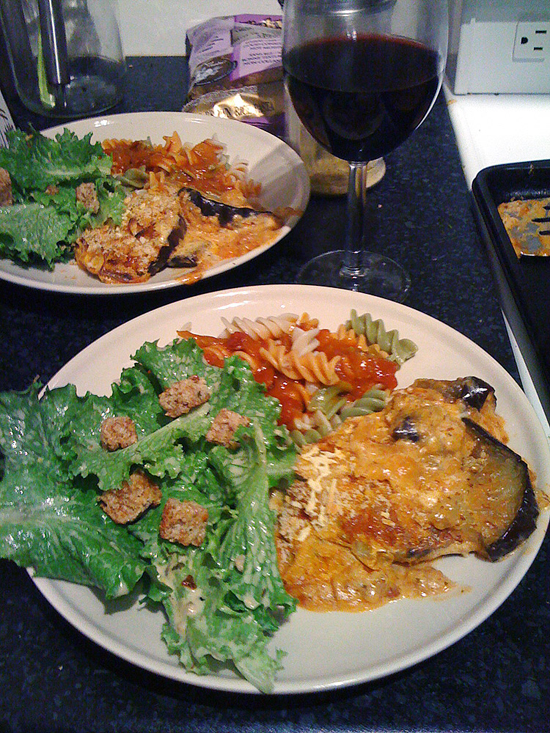
The Mischievous Vegan1
Posted In Blog,Food & Drink,Vegan
By Malloreigh
If you’ve chosen not to eat animal products, what’s the point in making “fake” versions of them? I get this question all the time. A lot of people don’t seem to understand why vegans and vegetarians find it necessary to make faux meats and cheeses, or construct veg versions of meaty, dairy-filled foods.
Every culture has its own food and its own customs surrounding meals – even if you’ve never left your white bread suburb, you’ve probably encountered ethnic food of some kind. Food, and the experience of eating it, is a spiritual practice; it’s an instrument of cultural cohesion that binds people together despite long distances and changing religions. From holiday feasts with your family to business meetings over lunch, food has always, and will always, function as a centerpiece for cultural events and ritual. It’s also rich to our senses – both taste and smell – and therefore is strongly linked to memory.
There’s a reason we haven’t adopted the common sci-fi prophecy of eschewing the time-consuming process of cooking and eating in favor of nutrition pills. Food is enjoyable, important, and culturally meaningful, and it is for this reason that vegetarians make “faux” versions of omnivorous meals.
When I decided to go vegan, it wasn’t because I hated the food I’d grown up eating. It had to do with concerns for the environment, for animals, and for my health; I wanted to reduce suffering in the world and saw that I personally didn’t have to suffer in order to make that happen. In fact, I could construct elaborate meals that satisfied my nutritional and cultural needs and still reduce suffering in the world. How novel!
So, to celebrate my first article as the vegan columnist on the SG Newswire, I’d like to share the following recipe. This vegan version of Eggplant Parmigiana is rich and flavorful and reminds me of the meals I ate as a child, prepared by my ethnically Italian family. For me, a feeling of nostalgia and indulgence accompanies this dish; it is pure comfort food. I don’t have to miss out on that feeling just because I’ve chosen to reduce my footprint. And as an added bonus, it’s cholesterol free, unlike its omnivorous cousin.
This recipe is based on one I found at FatFreeVegan.com. However, I’ve made it somewhat richer and more delicious with a few of my own modifications.

VEGAN EGGPLANT PARMIGIANA
- 1 large eggplant, sliced into 1/4″ thick rounds
- 3/4 cup breadcrumbs or Panko
- 1 tsp garlic powder
TOMATO SAUCE
- 2 tbsp olive oil
- 1 medium onion, diced
- 3 gloves garlic, minced or pressed
- 4 sun dried tomatoes, diced
- 2 bay leaves
- 1 tsp tarragon OR dried basil
- 1/2 cup vegetable broth (or 1/2 veg bouillon cube and 1/2 cup hot water)
- 2 tbsp tomato paste
- 1 16-ounce can diced tomatoes
- Salt, to taste
CHEESE SAUCE
- 1/2 cup vegetable broth (or 1/2 veg bouillon cube and 1/2 cup hot water)
- 1/3+ cup shredded vegan cheese – I used Daiya – OR 1/2 cup silken tofu
- 2 tbsp tahini or cashew butter
- 1 tbsp mustard (Dijon works best)
- 2 tbsp nutritional yeast
- 1 tbsp tapioca flour or corn starch
- Salt and pepper, to taste
Salt the eggplant slices and put them in a colander to drain. The salt draws out the bitterness of the eggplant.
Prepare the tomato sauce in a saucepan over medium-high heat. Heat the oil, then add the onions, and saute until they begin to soften. Add the garlic and saute for another minute, then add the sun dried tomatoes, bay leaves, and tarragon. Stir together and let the spices toast for a couple of minutes. Make sure to stir regularly. Mix the tomato paste into the broth until it’s smooth. Add that and the diced tomatoes to the saucepan, bring to a boil over medium-high heat, cover, reduce the heat and let it simmer.
For the cheese sauce, you will ideally need a blender or food processor. Combine all ingredients and blend until smooth. Blend again just before using to ensure that the ingredients haven’t separated. If you are cooking without mechanical aid, mix the ingredients together by whisking in a saucepan over medium heat until combined. Remove from heat.
Set your oven to broil.
Rinse the eggplant slices and place them on a baking sheet. Spray or brush them with a light layer of olive oil and broil them for three minutes, until they start to brown. DON’T BURN THEM. This will ensure that they will be completely cooked inside of your casserole. Nobody likes undercooked eggplant; I think it’s the reason so many people think they don’t like this delicious nightshade.
Mix together the breadcrumbs and garlic powder.
Set your oven to bake at 350 degrees Fahrenheit. Grease a small non-metal baking dish.
Assemble the casserole by lining the bottom with half of your eggplant slices, making sure they overlap. Sprinkle with 1/3 of the breadcrumbs. Spoon half of the tomato sauce evenly over top and pour half the cheese sauce on. Repeat: eggplant, breadcrumbs, tomato sauce, cheese sauce. Top with the rest of the breadcrumbs, some nutritional yeast, and some more faux cheese if you have it.
Bake for 16 minutes. Switch your oven to broil and brown the top – it should take about 2 – 3 minutes.
Serve with pasta and salad.

